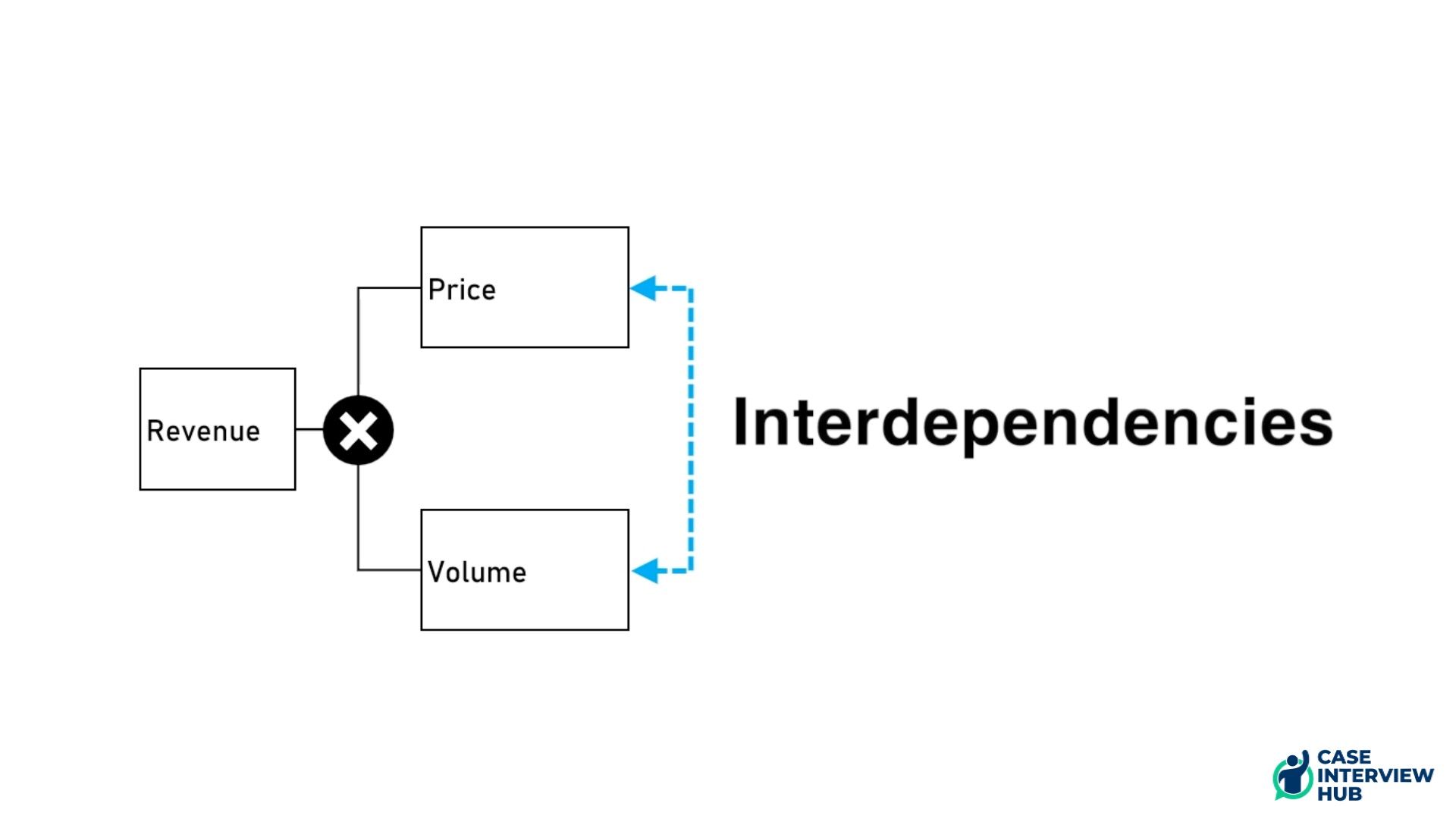How MECE helps your Case Interview Preparation
MECE is a core concept of consulting and thus also helps in the case interview. Especially McKinsey, BCG & Bain put an emphasis on structure and this is where MECE comes into play. In this article, we detail what exactly MECE is and how to apply it in your case interview practice.
Nov 16
/
Case Interview Hub
What does MECE stand for?
MECE stands for Mutually Exclusive Collectively Exhaustive and is used for breaking down…
-
… a big problem
-
… a complex topic
-
… a range of ideas
-
… a consulting project
in a structured way.
Mutually exclusive means that the individual components of the breakdown are not overlapping.
Collectively exhaustive means that these components taken together, cover the entire problem.
Collectively exhaustive means that these components taken together, cover the entire problem.

Let’s apply MECE to a consulting project. In practice, MECE is important for consultants because projects are typically complex and need to be broken down into manageable work packages. And once you broke down the project, you don’t want multiple consultants working on the same topic without them knowing about it. That’s a wasted effort. So you want to break down the work packages in a way so that they are “mutually exclusive” so that you don’t do any double work.
But if you cut up the work, there is of course the danger that you overlook something and don’t cover all deliverables of the project. You don’t want to drop the ball on anything just because there’s an area you failed to investigate. So you need to design your work packages in a way that they are “collectively exhaustive”. The sum of the parts should cover all the potentially relevant areas.
The MECE concept does not only help for consulting work but also for all other sorts of structured writing. For example, when you have to structure a thesis or write a scientific article.
If you want to learn more about MECE we highly recommend the book “The Pyramid Principle” by Barbara Minto. She is a former McKinsey consultant and developed the MECE concept in the 1960s
How to apply the MECE concept in a case interview?
You should always keep the MECE concept in mind when solving a case interview but there are a couple of instances where the principle is particularly important.
The first is the opening structure. Here you are asked to structure the problem that was laid out to you by the interviewer in the case briefing. This structure obviously needs to be adapted to the case context, but should also be logically coherent. Of course there are a couple of standard frameworks that are good to know, such as the profitability framework or the business situation framework. These frameworks can be useful but apart from giving you guidance on a potential way to structure the problem, there is no point in memorizing countless frameworks. They will never be perfect and it will irritate the interviewer if you simply try to force fit an ill-suited framework onto the problem.
Instead, you need to be flexible with your framework and quickly build and customize them. You can start off with a well-known framework, say the profitability framework. But how you can further break this down is highly dependent on the case context.
Let us look at the revenue branch here. Maybe you say, “items sold” times “price per item”. Or you say “number of customers” times “spend per customer”. Or you say “North America”, “Europe”, and “Rest-of-world”. All of them could be valid, if the case calls for it. And you may still combine them. Say you have, for each of these regions, the number of items and the price per item. This allows you to identify where in the world you may have an issue and whether its a problem of volume or a problem of pricing. Or you break it down by online and offline channel. And within that, we can break it down by age group or by gender. And within that, you can again break it down by number of customer, and spend per customers.
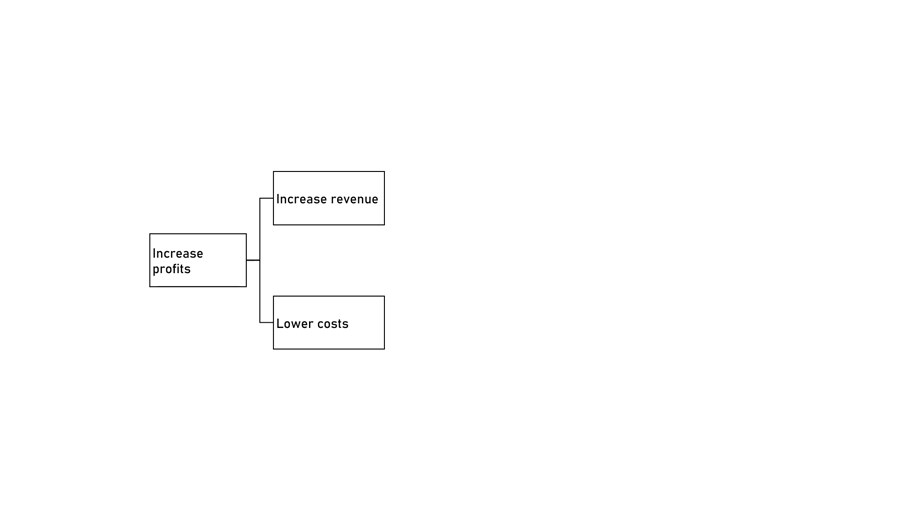
All of this just goes to show that you have to be able to break down the problem in whatever form is most suitable. And if you are not familiar with MECE thinking or inexperienced in its application, you will get yourself in a messy structure quickly that will not only confuse you but also the interviewer.
The second area where MECE comes in handy is idea generation or creativity tasks. Sometimes you’re asked for measures to solve a problem or ideas to improve the situation. Then it is most often not the best idea to just blurt out things that come to mind. Bringing a bit of structure into your thinking for these type of questions can be very beneficial. Even if it sounds counterintuitive, structure can foster creativity, at least creativity in a business or consultant our sense.
Imagine that you realize in the case that your client, a grocery retailer, has costs that are too high, and you’re asked for ideas to reduce costs. The first things that come to mind could be the following:
-
Fewer employees
-
Buy merchandise cheaper
-
Save energy
Of course the first couple ideas will come to mind quickly but soon the stuttering will begin.
If instead, you break down the problem into manageable pieces, you can work on them in a more focused and pinpointed way. Here is a breakdown into cost categories and you will notice that its MECE. And for each of these categories it is now much easier to think of a few very concrete ideas:
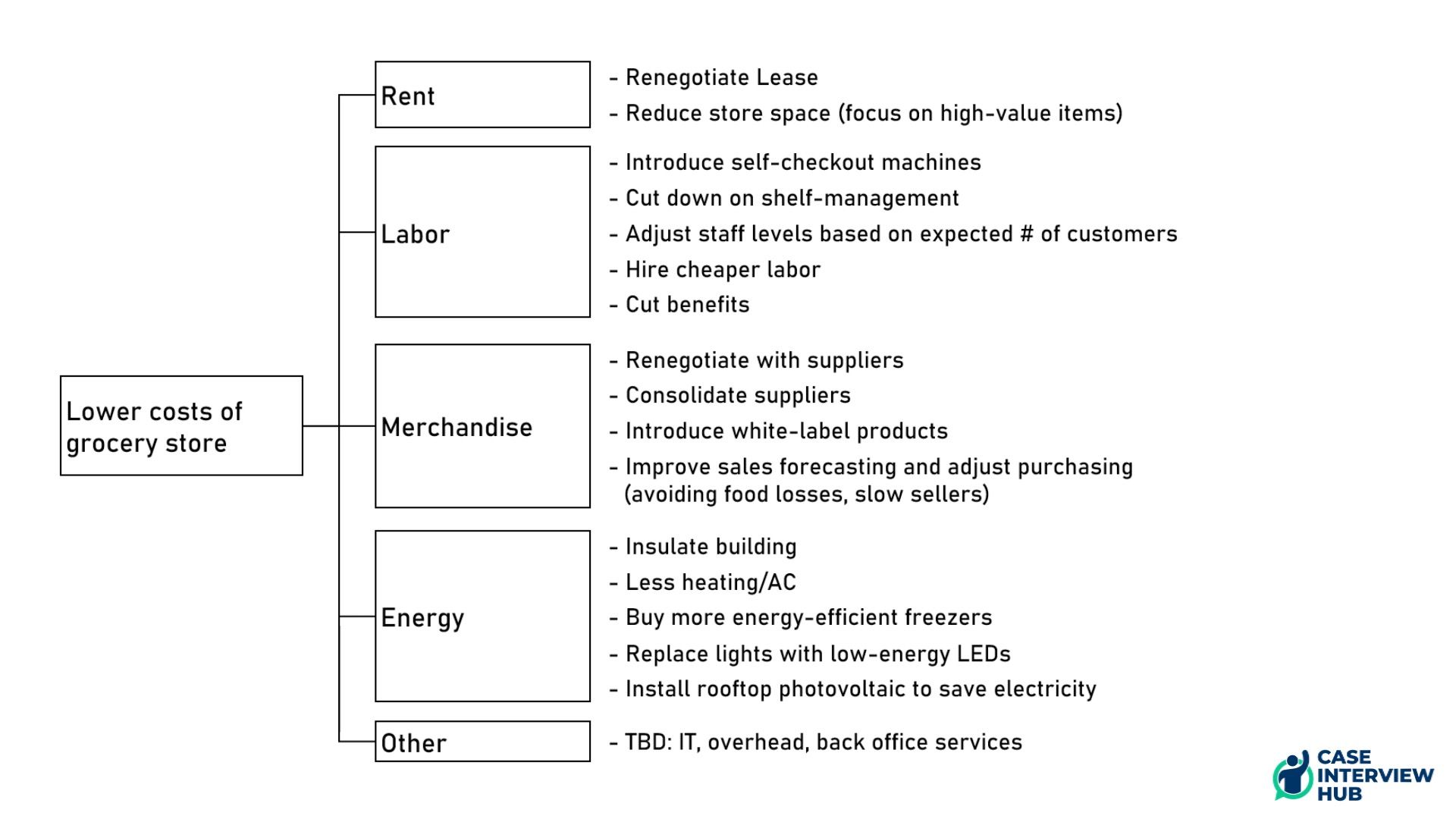
The “Other” category is just to make it collectively exhaustive and naming some of the areas that you can still look into without stating concrete ideas yet. Interviewers will often push you for stating more ideas and this is where the “Other” category comes in handy. Now, whether these are the most relevant ideas or even good ideas depends on the context.
But you can see right away that this is a much more structured way to approach the problem. If you focus on one area, you can come up with specific ideas quickly, whereas you will suffer from cognitive overload if you are trying to solve it all at once. And this is backed up by science.
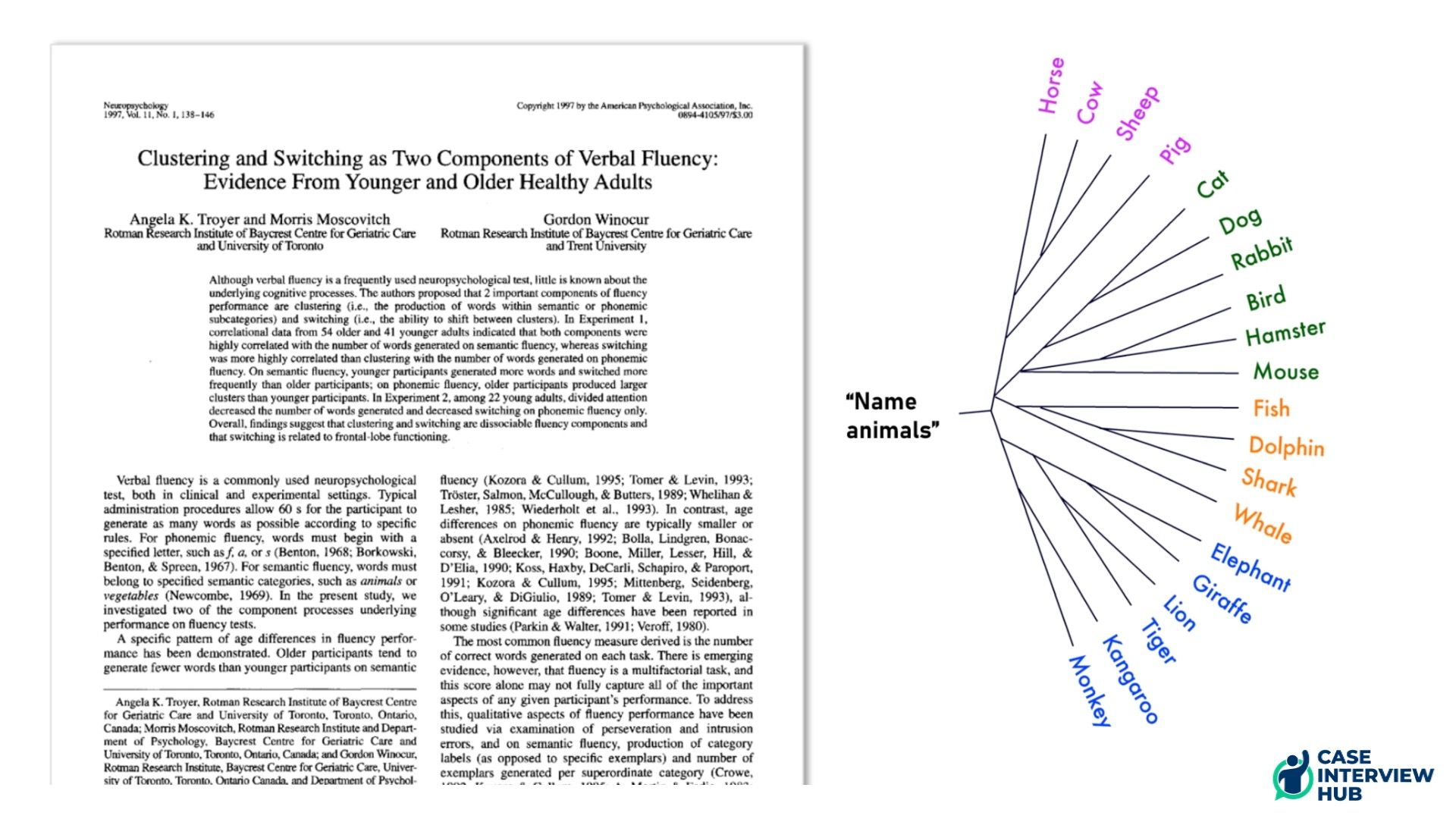
You will produce the most ideas in a given time by looking at individual semantic or topical clusters and after a short burst of ideas you can move to the next cluster, where you will again have a couple of ideas quickly before you move on to the next category. Rinse and repeat.
You see that breaking down a problem in a MECE fashion quickly is a super useful tool, not just in trying to pinpoint a specific problem, but also in divergent thinking, producing as many ideas as you can. And one added benefit of this breakdown is that you can also communicate your ideas in a more structured way to the interviewer. You can simply go topic by topic, instead of rattling off an unstructured laundry list of ideas. This is torture and you couldn’t do this to a client either.
What are useful MECE structures?
You may ask yourself what useful MECE structure are and how you can think of a MECE structure quickly and apply it flexibly. As with many things, with practice you will develop a feel for it but there are typically a few natural ways of breaking down a problem.
The first is a mathematical breakdown. We have already done that in the beginning of the prior paragraph:

There are always plenty of opportunities for a mathematical breakdown and you can always look for the most sensible way. Maybe you are overwhelmed by the revenue per year. Well, break it down
to revenue per day, times opening days per year. The revenue per day is
the revenue per hour times opening hours per day. A breakdown like this
one can be particularly useful in operations cases.
Or you say our revenue is market size times market share. And you can focus on increasing your market share or you focus on bigger markets or markets with higher growth.
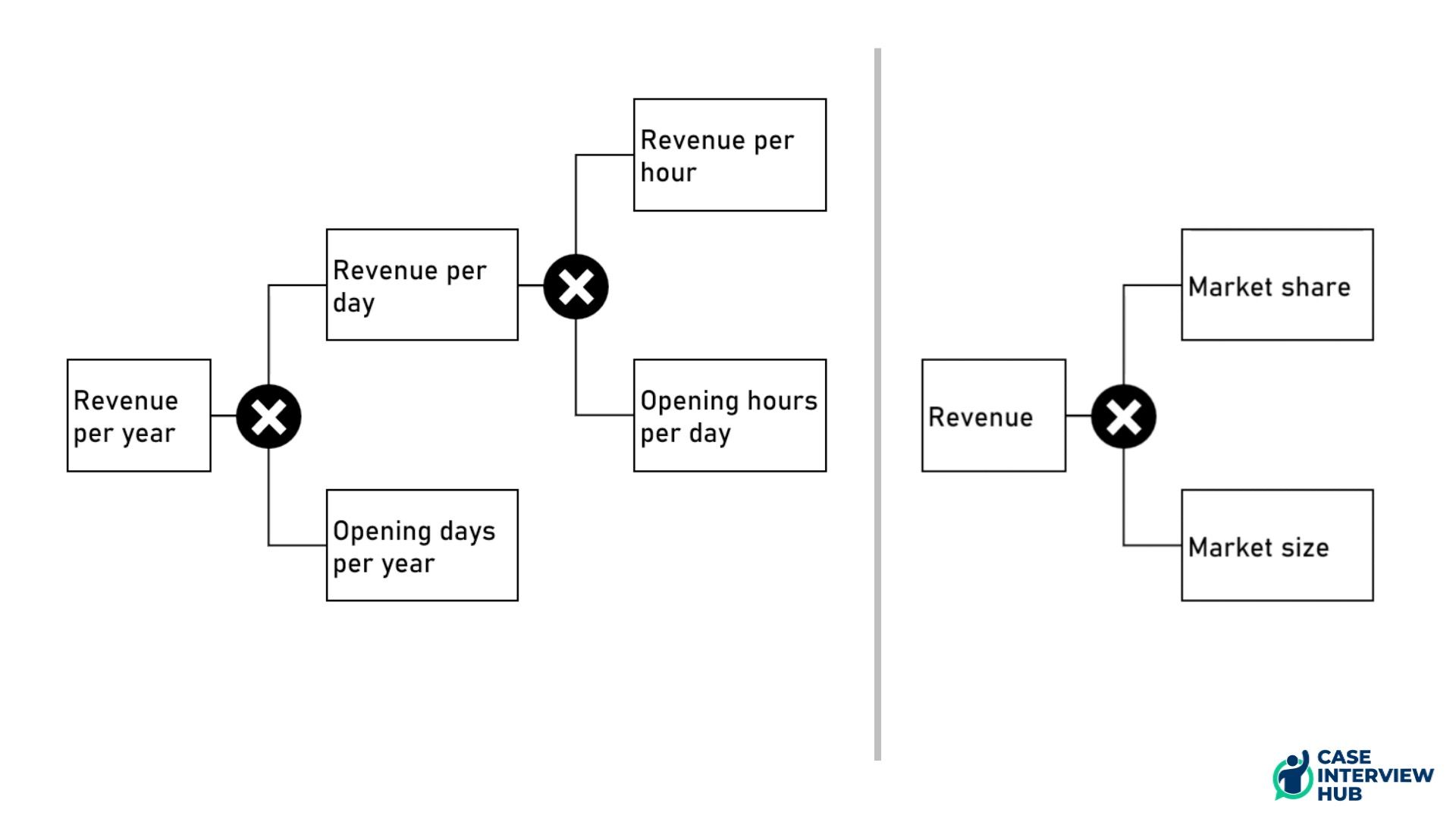
Next, there are process structures. Whenever something can be thought of as a sequence of steps, you can try break it down into these steps. That is often useful for more qualitative problems. Let’s say, we want to identify issues in our production process. Say, we have inbound logistics, then machine 1, machine 2, packaging, and outbound logistics. Now you can look for the issue in a much more targeted way.
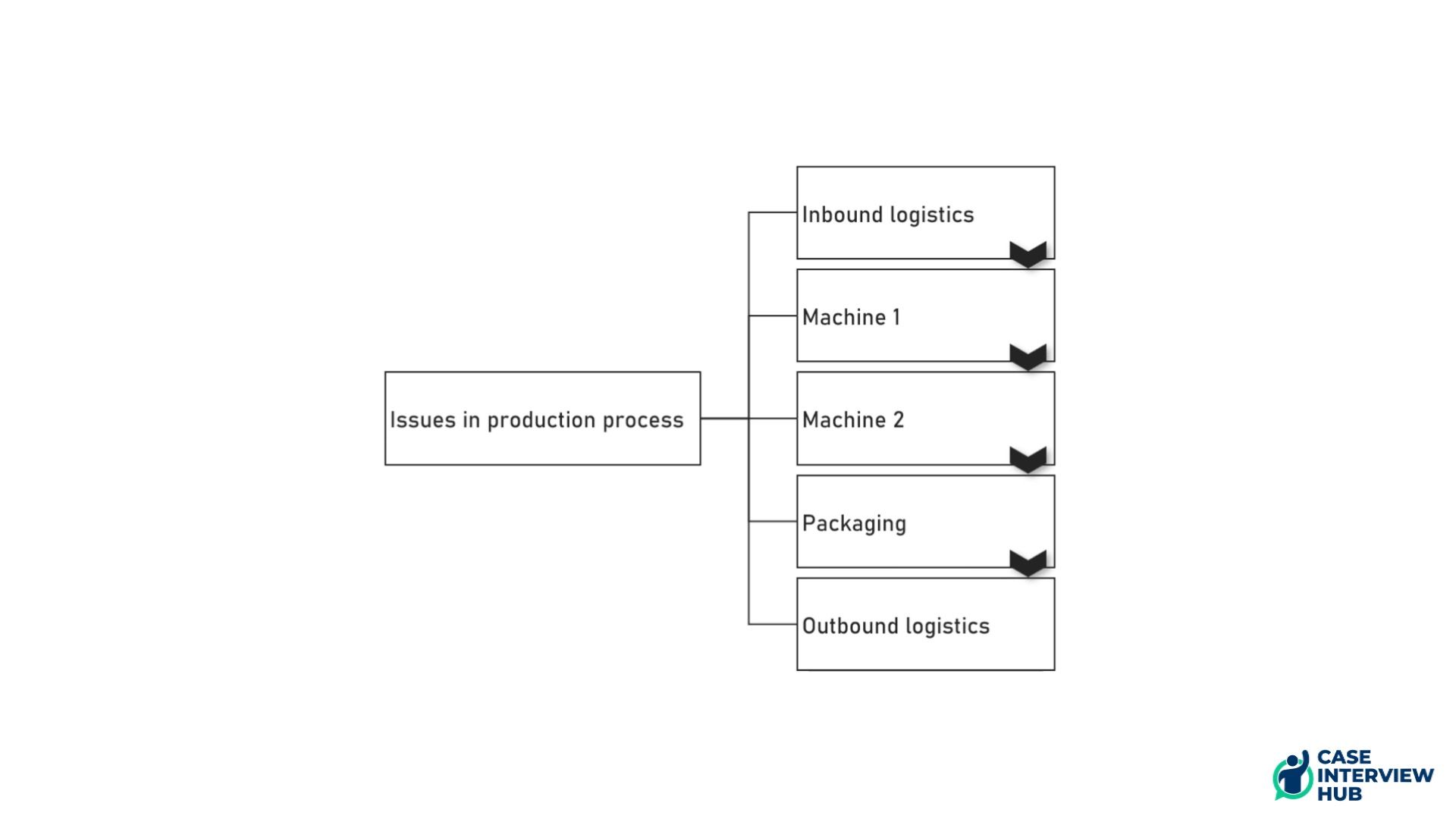
An e-commerce funnel is a classic example as well:
-
How many customers are visiting your website?
-
How many of them are actually looking at a product?
-
How many add it to the cart?
-
How many are actually completing the checkout process?
-
How many are returning their goods?
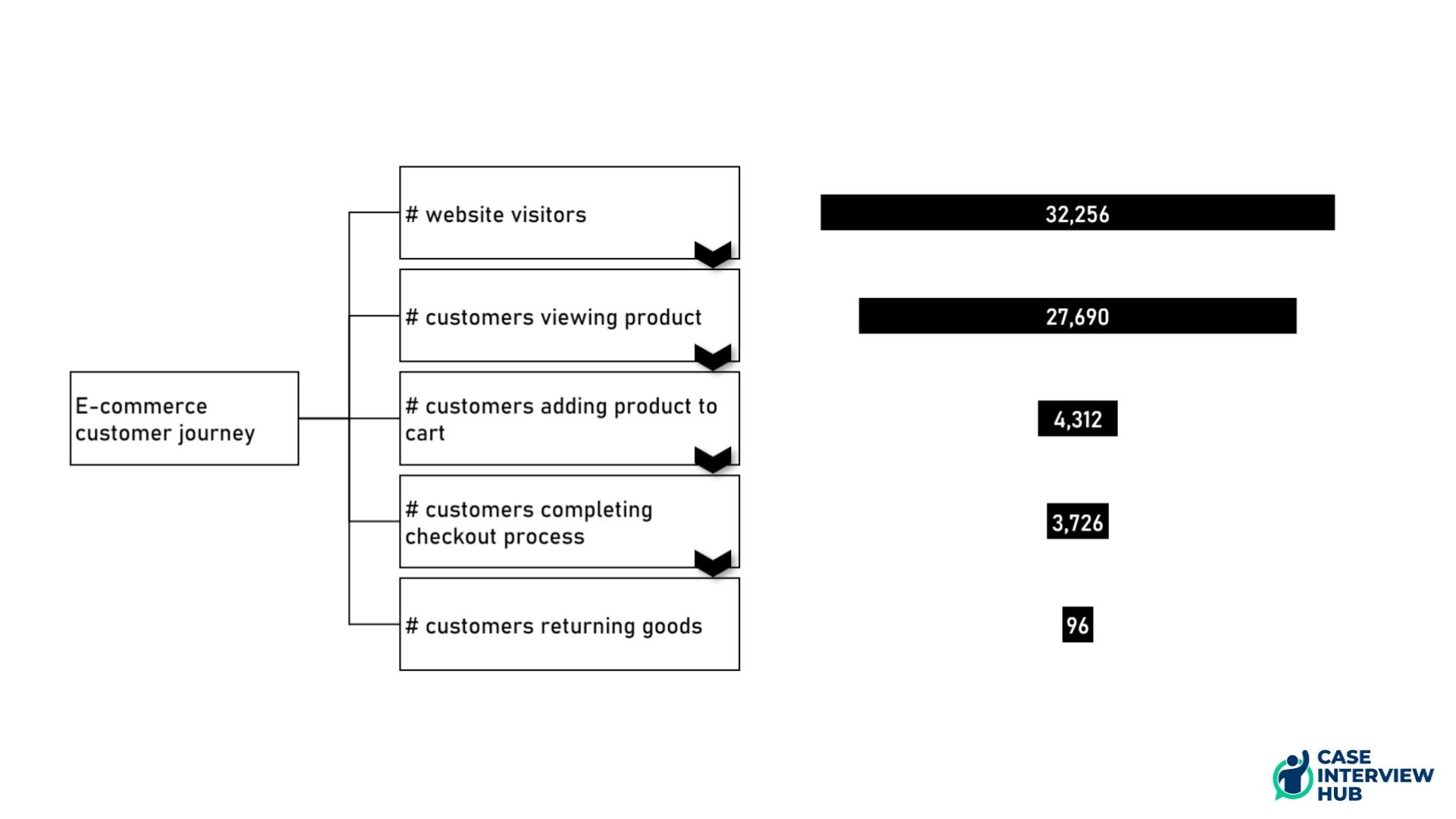
That’s a very natural, but also MECE way of looking at things.
Next, there is segmentation. If you want to break down your problem you can simply think of segments that are MECE. Maybe they are:
-
Demographics: age groups, gender, ethnicity
-
Socioeconomic: income, wealth
-
Geographies: Americas, EMEA, APAC
-
Channels: online channel (phone, internet), offline channel (retail, wholesale)
Those are already some of the most classic ones but there are surely more. Just make sure that the segments cover everything and that they are not overlapping.
One trick to make sure that you covered everything is that you add a bucket that is called “Other” - similar to what we did earlier in the retail example. If you can’t think of more segments or they are too small to be treated separately, it’s a useful catch-all category.
Of course, you also have to make sure the categories are not overlapping. You often see age groups broken down in such a way, but clearly, that’s wrong as they are not mutually exclusive. Pay attention to this when breaking down into age groups in your case interview.
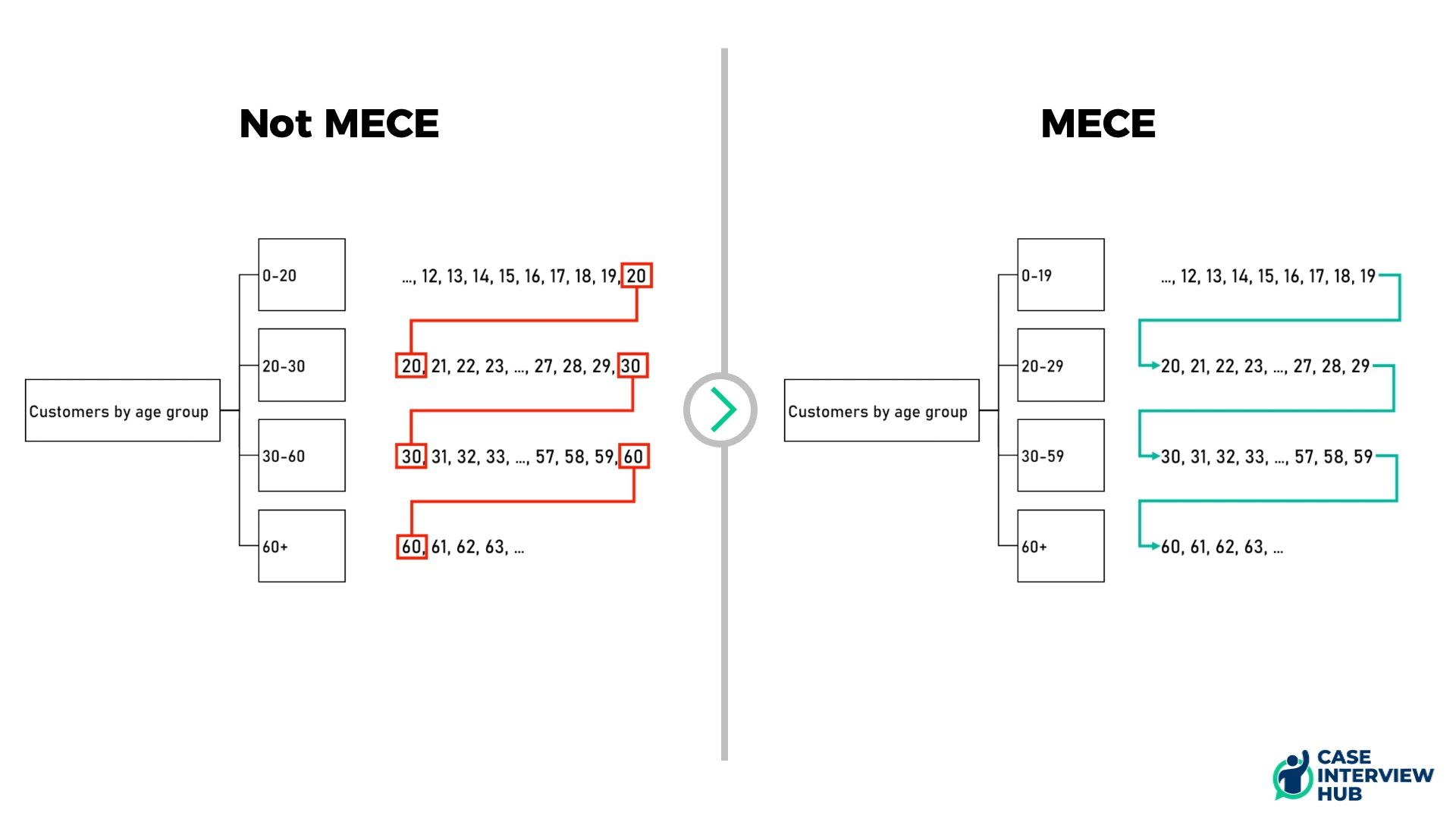
Then there are natural opposites. For example, internal and external factors or financial and non-financial reasons or supply and demand. These are already the most important ones but they are extremely useful. And you can cut down pretty much every problem in half easily by applying opposite words. Why are customers leaving us? Well, it could be the price. Or it could be non-price-related reasons.
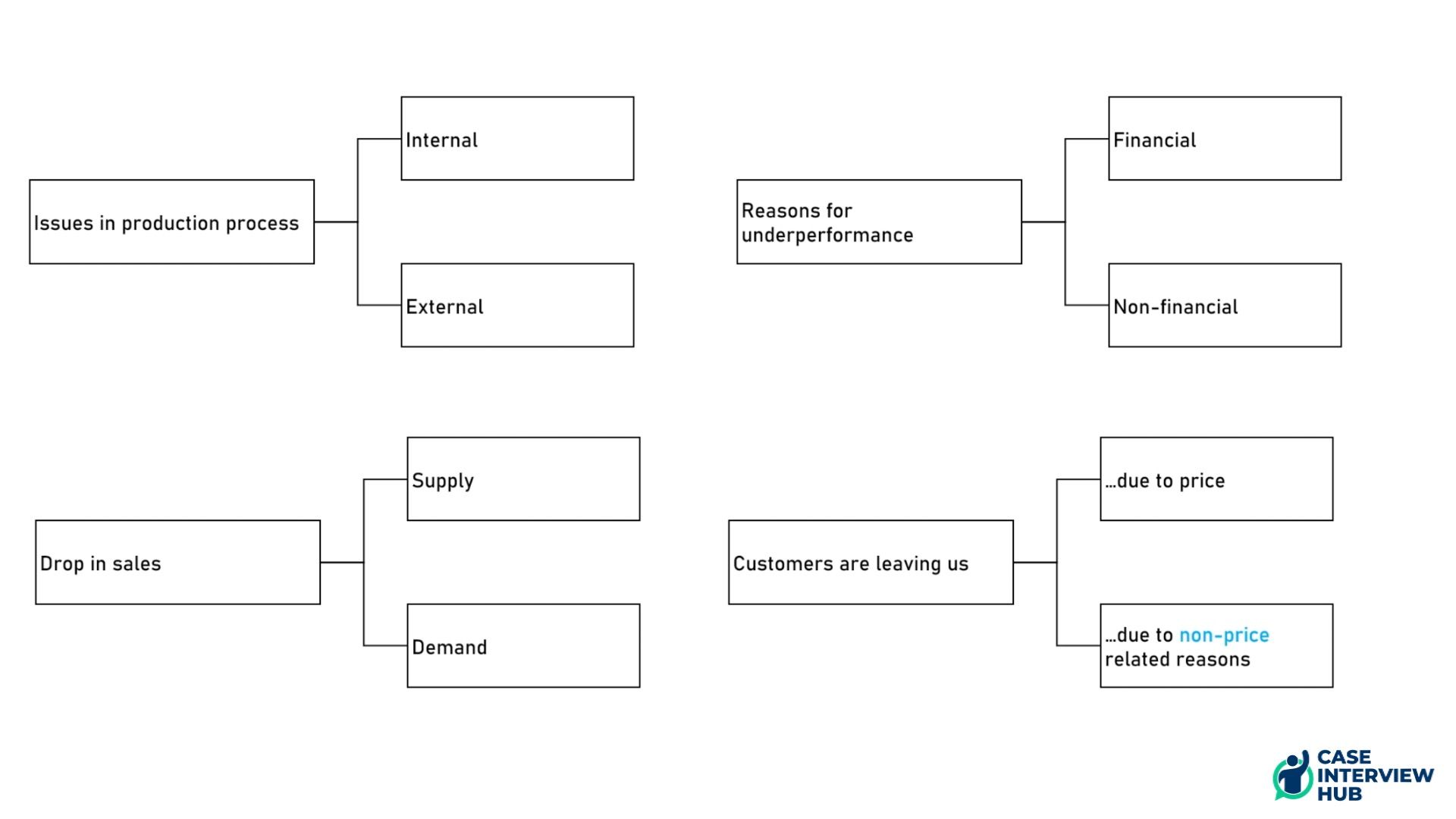
And that’s basically it. With these structures and concepts, your MECE toolbox should be well-equipped to tackle virtually all of the problems you may encounter. Of course, in some instances a ready-made structure, such as Victor Cheng’s business situation framework or the classic profitability framework, can be useful. But we don’t recommend studying and memorizing a long-list of frameworks beyond them and instead focus on becoming really good at building custom frameworks quickly – by using, adapting, and combining all these MECE mini structures you just learned.
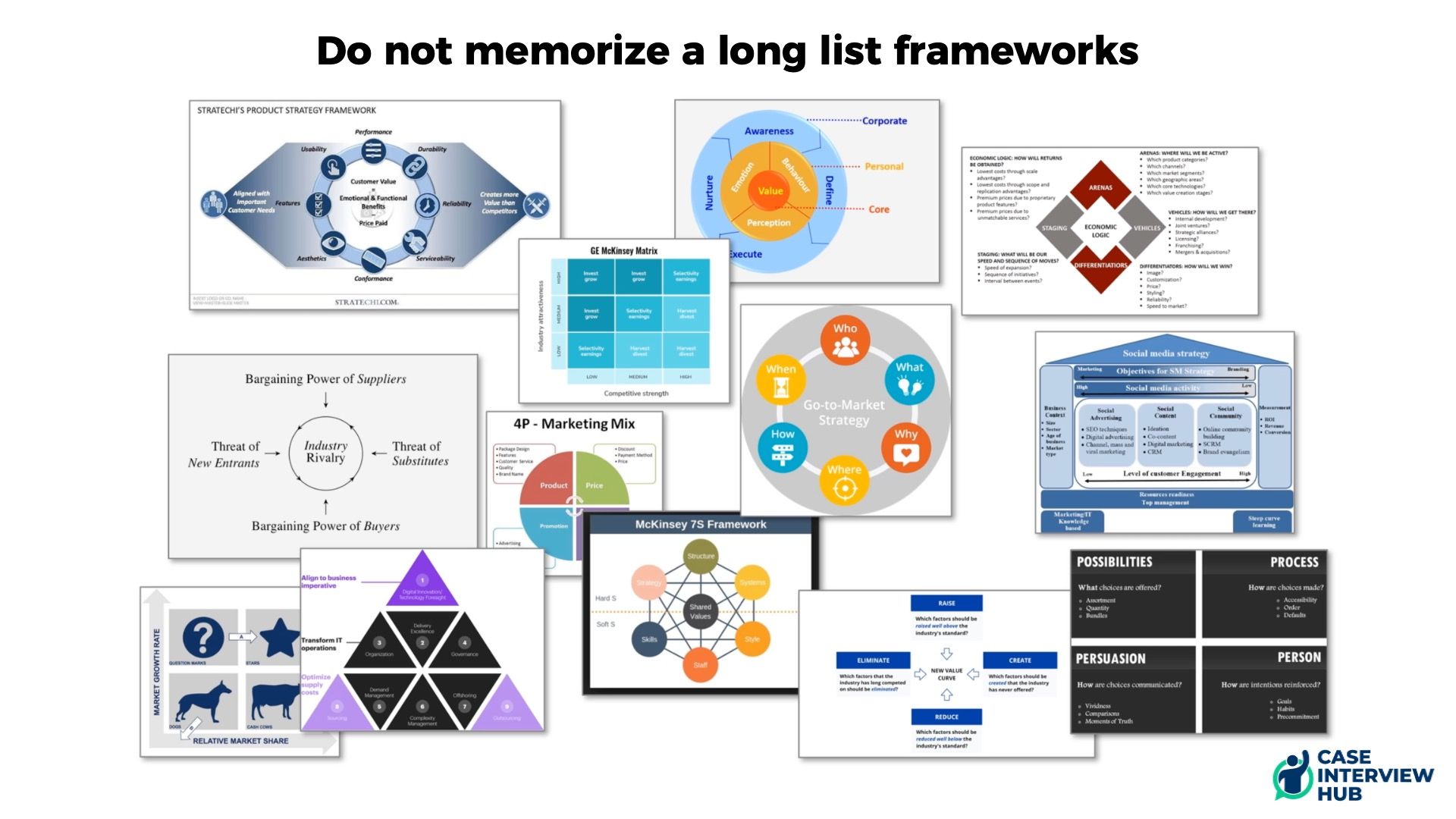
A final word of caution:
Even if the frameworks presented here are super useful, they are not always perfectly MECE. The best example is if you break down revenue into price and volume. Of course, changing the price WILL have an impact on volume. But that’s still as good as it gets in many situations. The important part is being aware of such imperfections. And pointing out the interdependencies between your thoughts is actually a hallmark of a great candidate.
Even if the frameworks presented here are super useful, they are not always perfectly MECE. The best example is if you break down revenue into price and volume. Of course, changing the price WILL have an impact on volume. But that’s still as good as it gets in many situations. The important part is being aware of such imperfections. And pointing out the interdependencies between your thoughts is actually a hallmark of a great candidate.
